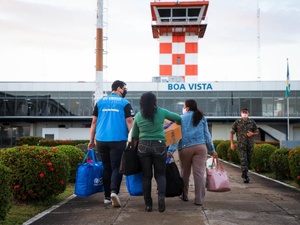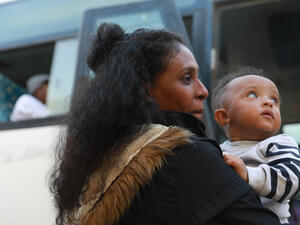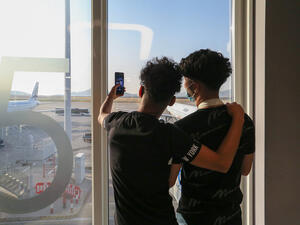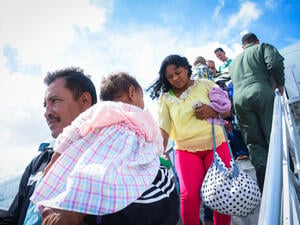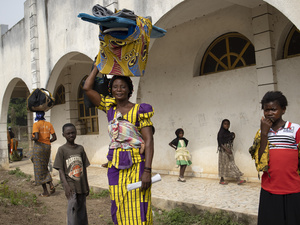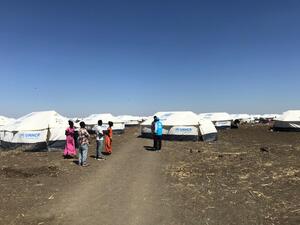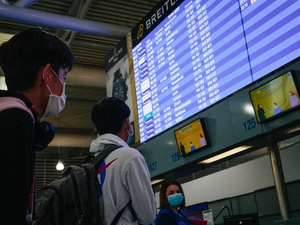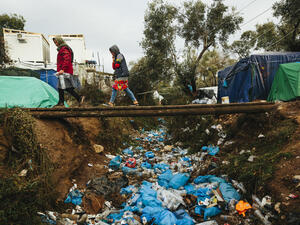UNHCR moves Congolese refugees to safety in Burundi
UNHCR moves Congolese refugees to safety in Burundi
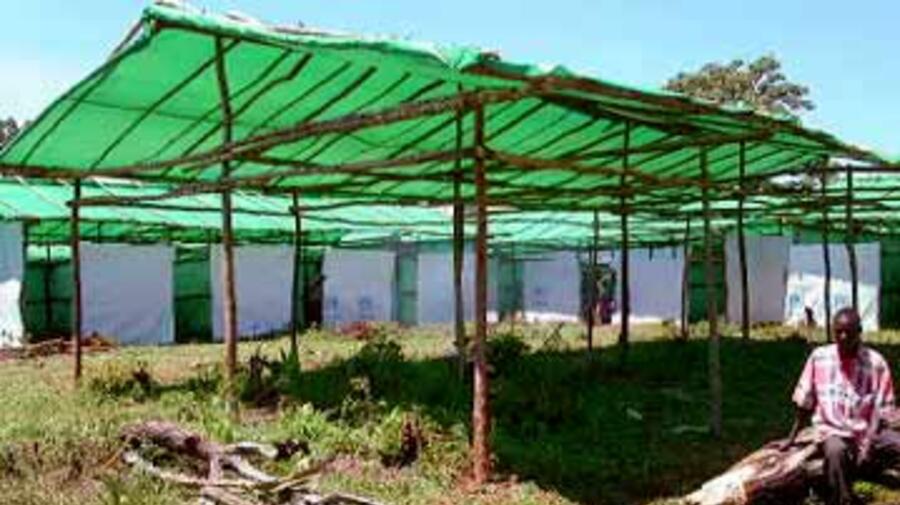
The newly-built Cishemeye II transit centre awaiting the arrival of Congolese refugees from the Burundi/Congolese border area.
CISHEMEYE, Burundi, Feb 13 (UNHCR) - With an eye to security, the UN refugee agency this week stepped up efforts to get Congolese refugees to move further inland in Burundi, away from the border with the volatile Democratic Republic of the Congo (DRC).
On Wednesday, some 406 refugees boarded UNHCR trucks at Rugombo reception centre for the short ride to Cishemeye I transit centre. In coming days, 3,000 more refugees are to be transferred to the newly-built Cishemeye II. Like Rugombo, both Cishemeye centres are in north-western Cibitoke province, but they offer better living conditions for the refugees. UNHCR officials would like to move them even further away from the DRC border.
"We are grateful to the government of Burundi for its open door policy towards refugees, and for its assistance to us," said UNHCR Representative in Burundi, Stefano Severe.
The refugee agency began transferring refugees away from the border area at the end of January. Some 206 Congolese refugees were moved to Gasorwe refugee camp in northern Burundi from Gatumba reception centre, a makeshift collection of plastic-sheeting shelters that is designed to process refugees when they arrive, not to house them for longer periods.
"Because of the volatility of the situation, we want to move as many as possible out of Cibitoke province to Gasorwe refugee camp," said UNHCR's Severe. "However, the refugees, particularly those who have cattle, want to stay close to the border to observe the situation and go back when they need to."
This makes it difficult for UNHCR to protect them. "There have been incidents of people being exposed to danger," added Severe.
Benoit Hamenyimana, a field assistant for UNHCR at Gatumba, knows how precarious life is for the refugees there. "Gatumba is just too close to the border - only 3 km away," he said.
The number of refugees who insist on staying close to the border with the volatile eastern region of the DRC has stretched UNHCR's capacity to serve them well. Rugombo is home to more than 5,000 refugees and Gatumba is still housing some 100 refugees, although neither reception centre was designed to provide long-term housing.
Refugees at the two reception centres recently told UNHCR officials they were dissatisfied with their living conditions.
"We are living in hangars (made of plastic sheeting) where the people are packed in. It is terribly overcrowded. Families are mixed, and the hangars leak when it rains," said Placide Magy, a refugee leader at Rugombo. "The health conditions are bad and rations are insufficient. In general, things are just not working."
Shabani Macozi, a 38-year-old Congolese mother of six, held up a thin cotton shawl wrapped around her shoulders and complained, "This piece of cloth is all I have. It's all I have to sleep on, or to keep myself warm." She said she is sleeping on the dirt floor of a communal kitchen because she has not been allocated a place in a hangar, even though she arrived last October.
Bin Maheshi, a 51-year-old Congolese farmer, came to Rugombo last October after fighting broke out in eastern DRC between two rebel groups, the RCD-Goma (Congolese Rally for Democracy) and the Mai Mai militia. He arrived in Burundi with two of his three wives and 18 of his 21 children.
Holding up a piece of paper on which he has listed his complaints about Rugombo, he said, "There is a lack of food rations, health care is insufficient and there is a lack of kitchen sets and blankets." Then he makes a concession: "The conditions under which the refugees live are bad, but since the war (in DRC) is continuing, and there is lack of security, we can put up with it."
The inability to take proper care of the refugees in the two reception centres is precisely why UNHCR would like to see them move into real camps, said Severe.
It is an argument few of the refugees have accepted so far. "They don't want to move further," said UNHCR's Hamenyimana at Gatumba. "They say, 'We are just watching developments over there.'" Their homeland is clearly visible from Gatumba, just a bit further along the shores of Lake Tanganyika.
UNHCR officials also say many of the refugees routinely cross back and forth between DRC and Burundi to maximise the amount of food aid they get from the refugee agency and various non-governmental organisations.
Meanwhile, representatives of the RCD-Goma, the faction that controls the area of eastern DRC that most of the refugees fled, are actively encouraging them to return home, saying the situation is now stable.


